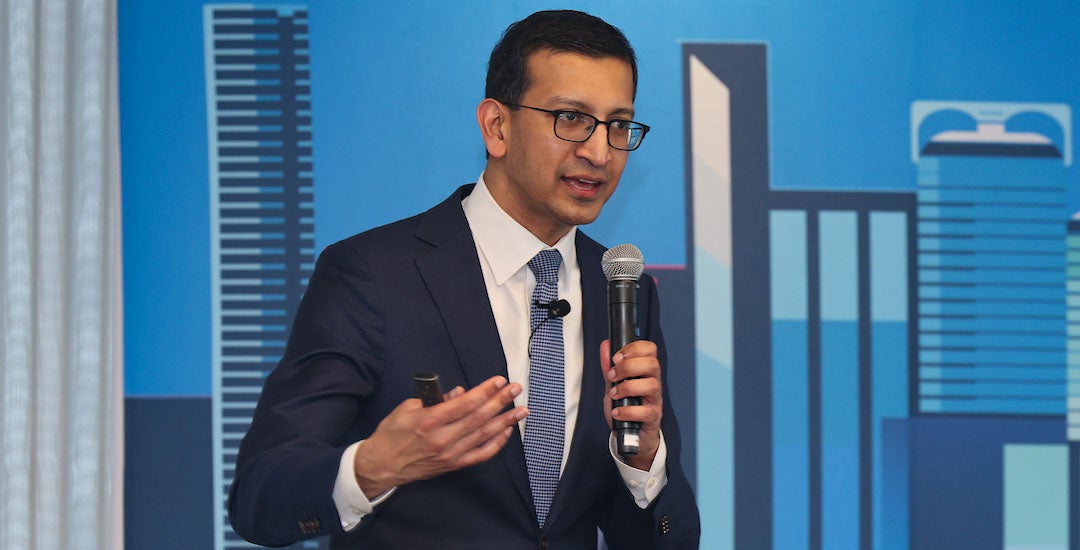By measures basic and complex, Houston hasn’t been a pillar of economic mobility for lower-income residents.
In simple terms, the region’s poverty rate has risen since the 1980s, even as energy, health care and other industries flourished. A more detailed measure of climbing the economic ladder, comparing local children’s income in adulthood to their parents, ranks Houston as eminently average relative to the rest of the country.
“A lot of times, we talk about Houston as this booming economy,” said Flávio Cunha, director of the Kinder Institute for Urban Research’s Center for Economic Mobility. “It is definitely a true statement, but we don’t talk enough about the fact that we’re leaving a lot of the locals behind.”
The juxtaposition of a thriving local economy and modest progress in boosting many Houstonians’ financial prospects spurred conversation — and several research-based ideas — among prominent community leaders last week at the region’s first Economic Mobility Summit.
The gathering explored extensive data on the state of economic mobility — typically defined as the movement of people between income levels — in Houston and opportunities for reversing decades-old trends. Influential leaders in the field, including Harvard University economics professor and Opportunity Insights director Raj Chetty, Urban Institute President Sarah Rosen Wartell and the Kinder Institute’s Cunha led the event.
Local business, philanthropic, education and other civic leaders framed the discussions as an early step toward regionwide action on the issue. Here are some of the top lessons and ideas imparted.
Chetty: The promise of mixed-income communities
Chetty has published some of the nation’s most influential research on economic mobility over the past decade, harnessing large data sets — including millions of anonymized tax returns — to broadly gauge income patterns between generations. He and fellow researchers have identified a few of the most influential factors, including neighborhood poverty levels, family stability and local school quality.
One particularly big element of economic mobility, Chetty said, is the frequency and quality of interactions between people from different income brackets.
Chetty’s research showed children from lower-income families who live in areas with higher economic mobility — typically neighborhoods with more wealth — ultimately have better odds of earning higher incomes. What’s more, the chances of mobility are better when people from various income brackets regularly socialize, rather than merely coexisting near each other, Chetty said.
“If you’ve never met somebody who’s gone to college, never met somebody who’s pursued a career in science or business or other fields, I think that doesn’t even occur to you that it could be a possibility,” Chetty said. “If you’re in a community with these cross-class interactions, that creates pathways for kids they may end up ultimately pursuing, especially if they’re supported in pursuing these pathways.”
Chetty said there’s early promise in programs that give lower-income families information about high-opportunity neighborhoods and help them move into those communities. Chetty’s research, mapped in the interactive Opportunity Atlas, shows the neighborhoods with the best economic mobility track record for lower-income residents include southeast Harris County, Sugar Land and the region’s western suburbs.
Rosen Wartell: Houston’s built-in advantages
Building on the work of Chetty and other researchers, the Urban Institute created a framework for helping communities understand and act on the main drivers of economic mobility.
The nonprofit broadly identifies five pillars of mobility: rewarding work; high quality education, opportunity-rich and inclusive neighborhoods, healthy environments and health care access, and responsive and just governance.
Wartell, the Urban Institute’s president since 2012, said Houston is well-positioned in many ways to advance economic mobility. The region’s abundance of land and relatively loose zoning laws make it easier to build better housing and neighborhoods, she said. Strong collaboration between government and dedicated business and philanthropic communities also helps, Wartell said.
Still, Wartell cited one big Houston obstacle: “There is a lot of segregation of where people live in this community by income and race, and those places of isolation are where the data tells us people don’t have growth.”
The Urban Institute has worked with about 30 communities across the U.S. over the past few years to understand their economic mobility data and help chart the course for action. Wartell said it’s too early to measure the impact of policies enacted in those regions.
Cunha: Connecting employers, employees and educators
Cunha, who also serves as Rice University’s chair of economics, focused on Houston’s failure in recent decades to translate business prosperity into economic mobility.
Building on extensive national research, Cunha argued Houston and other communities have suffered from a breakdown in coordination between employers, workers and schools.
Rather than training up their current employees, many companies today prefer the cheaper option of hiring new employees with credentials they desire, Cunha said. This has been particularly true in Houston’s higher-paying industries.
“We're importing people. We attract brains,” Cunha said. “We have a tremendous, booming economy, but we're not producing the skills that the locals need to have in order for them to benefit from this growth.”
In response, Cunha emphasized the promise of strong jobs-focused programs that provide training in high-wage sectors, teach students soft skills and offer support in securing employment, among other features.
“A key aspect of these types of interventions is a strong connection between employers and the education sector,” Cunha said. “We are training these students to go into jobs that are high-paying jobs, and we’re making sure the training they actually get is training that employers value in the labor market."


